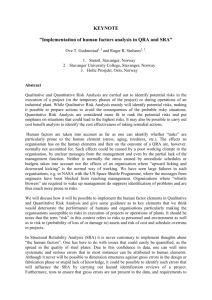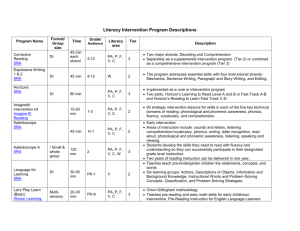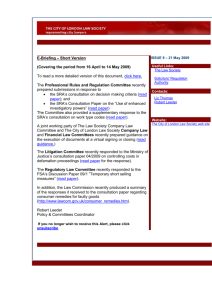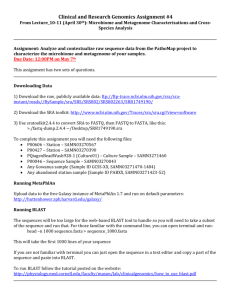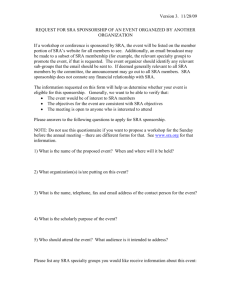Results from 6 years of Swedish measurements with Bridge WIM... 2009 RESULTS FROM 6 YEARS OF SWEDISH MEASURMENTS WITH BRIDGE
advertisement
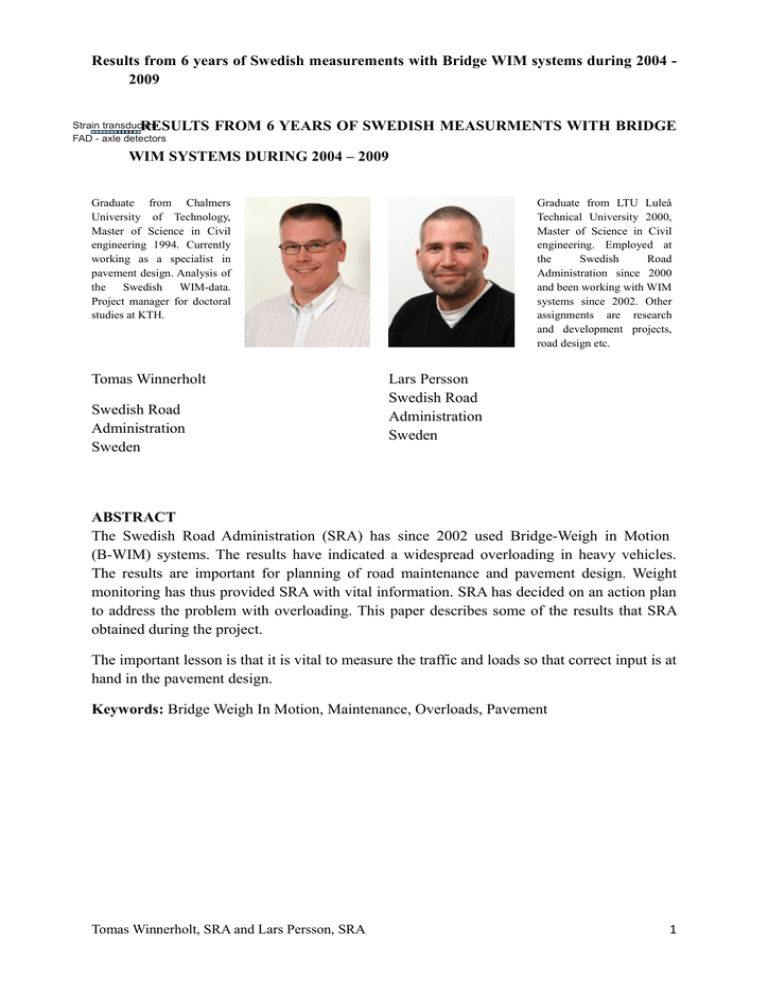
Results from 6 years of Swedish measurements with Bridge WIM systems during 2004 2009 Strain transducers RESULTS FAD - axle detectors FROM 6 YEARS OF SWEDISH MEASURMENTS WITH BRIDGE WIM SYSTEMS DURING 2004 – 2009 Graduate from Chalmers University of Technology, Master of Science in Civil engineering 1994. Currently working as a specialist in pavement design. Analysis of the Swedish WIM-data. Project manager for doctoral studies at KTH. Tomas Winnerholt Swedish Road Administration Sweden Graduate from LTU Luleå Technical University 2000, Master of Science in Civil engineering. Employed at the Swedish Road Administration since 2000 and been working with WIM systems since 2002. Other assignments are research and development projects, road design etc. Lars Persson Swedish Road Administration Sweden ABSTRACT The Swedish Road Administration (SRA) has since 2002 used Bridge-Weigh in Motion (B-WIM) systems. The results have indicated a widespread overloading in heavy vehicles. The results are important for planning of road maintenance and pavement design. Weight monitoring has thus provided SRA with vital information. SRA has decided on an action plan to address the problem with overloading. This paper describes some of the results that SRA obtained during the project. The important lesson is that it is vital to measure the traffic and loads so that correct input is at hand in the pavement design. Keywords: Bridge Weigh In Motion, Maintenance, Overloads, Pavement Tomas Winnerholt, SRA and Lars Persson, SRA 1 Results from 6 years of Swedish measurements with Bridge WIM systems during 2004 2009 1 Background SRA (The Swedish Road Administration) have since 2002 used bridge-weigh in motion (BWIM) systems. The results have so far indicated a widespread overloading in heavy vehicles. The result is important for planning road maintenance and pavement design. Weight monitoring has provided SRA with vital information. SRA has decided on an action plan to address the problem with overloading. In 2001, a system for weighing heavy vehicles was tested in Kyrkdal in the northern part of sweden. The results from those tests incuraged the SRA to further look in to the technology of weighing heavy vehicles. After some more testing SRA decided to start a project to investigate the loads on the road network. The object of this project was to gain a picture of the heavy traffic in terms of loads and occurrence of overloading (Lindeberg,(2008)). Through the knowledge about the loads on the road network and the occurrence and amount of overloads the SRA gains knowledge: • to implement a better obedience to rules, • to better planning of maintenance and rehabilitation of the road network, The project had the following sub goals: • Measure the actual loads on a few locations spread over the country to gain a picture of the load over many years. This has been done in two locations per region, in all 14 sites. • Give the regions knowledge of the load situation on two additional sites every year, in all 14 sites. • Get knowledge of how the loads varies and analyze how much the actual loads deviates from the ones stated in the design codes. • Get knowledge of the actual overload situation on the road network. • Gain experience to further improve the measuring methods. • Gain experience so that the weighing could be a part of the normal SRA activity. After the measuring season in 2009 SRA decided that the weighing should continue as a part of normal activities. It was therefore decided that a tendering process should start. The tendering process also consisted of a test measurement to make sure that the contractor could fulfill the demands placed upon the measuring. The test took place in the southern part of Sweden during November 2009. In December of 2009 the tending was completed and a contract was signed with the winning contractor. The new measuring period starts in March, 2010. Tomas Winnerholt, SRA and Lars Persson, SRA 2 Results from 6 years of Swedish measurements with Bridge WIM systems during 2004 2009 Tomas Winnerholt, SRA and Lars Persson, SRA 3 Results from 6 years of Swedish measurements with Bridge WIM systems during 2004 2009 2 Research Method 2.1 Equipment The Bridge Weigh in Motion system (B-WIM) used in Sweden is a portable system that is installed on the superstructure of an existing bridge, as seen in Figure 1. There are no components installed in the pavement or on the pavement surface. The system uses strain transducers (FAD) to detect axles and weighing axles. If necessary the system can use pneumatic cables on the surface. Figure 1 - Left -The system installed at a site in southern Sweden, Top right – The signal processing unit, Bottom right – Strain transducer Tomas Winnerholt, SRA and Lars Persson, SRA 4 Results from 6 years of Swedish measurements with Bridge WIM systems during 2004 2009 The data is stored in the signal processing unit and downloaded on site by the operators. The amount of data stored depends on the traffic of the road and the measuring period’s length. The FAD-sensors are offset from the strain transducers, as seen in Figure 2. There are two for each lane of traffic. When a vehicle approaches the bridge the FAD-sensors detects the oncoming vehicle. When the vehicle passes the strain transducers, the weight is detected and the data is stored in the signal processing unit. Figure 2 - Schematic of an installation, strain transducers in the middle. The system used is manufactured by the private company CESTEL in Slovenia, the system is called SiWIM, the software that is used in the system and during post-processing is developed by the Slovenian National Building and Civil Engineering Institute, ZAG. The system has been used at more than 300 locations around the world (CESTEL (2008)). The system has been presented and demonstrated at several conferences and exhibits. 2.2 Measuring programs Since 2004 the SRA has been running a measurement program on two levels. A national program with sites that are repeatedly measured for one week each year and a regional program that varies depending on the needs of the SRA regions. On average there are approximately ten regional sites each year. Fourteen sites were selected to be included into the national program, as seen in Figure 3. Those fourteen sites are located so that they cover the country geographically. The concentration is higher in the southern parts since the traffic density is higher there. Table 1 provides a brief overview of the sites. Figure 3 - Location of the National B-WIM sites in Sweden. Tomas Winnerholt, SRA and Lars Persson, SRA 5 Results from 6 years of Swedish measurements with Bridge WIM systems during 2004 2009 Table 1 - Overview of the measurements carried out in the National program 1+1 is one lane in each direction and 2 is two lanes in the same direction. Road type Road no. Station name No . of lan es Motorwa y E4 Torsboda 1+ 1 Motorwa y E4 Mjölby N 2 Motorwa y E4 Mjölby S 2 Motorwa y E6 Löddeköping 2 Motorwa y E10 Grundträskån 1 +1 Motorwa y E14 Torvalla 1+ 1 Motorwa y E18 Radmansö 1 +1 Motorwa y E20 Marieberg 2 Motorwa y E65 Skurup 1+ 1 Motorwa y Rv40 Landvetter W 2 Motorwa y Rv40 Landvetter E 2 Arterial Rv50 Gärdshyttan 1+ 1 Arterial Rv73 Västerhaninge 2 County Lv373 Storlångträsk 1+ 1 Tomas Winnerholt, SRA and Lars Persson, SRA 6 Results from 6 years of Swedish measurements with Bridge WIM systems during 2004 2009 2.3 Bridges The bridges that have been used in Sweden are all slab frame bridges. The road surface before and after the bridge has to be smooth so that as little dynamic effects as possible are induced to affect the results. Experience from the various tests that have been performed points to that the IRI (International Roughness Index) needs to be lower than 2,3 mm/m. Other criteria for bridge selection concerns installation issues and power requirements. After the installation is complete the system is calibrated using a pre-weighed seven axle truck (tractor with trailer) with known axle spacing, as seen in Figure 4. The truck is fully loaded. Figure 4 - Idealized calibration truck 2.4 Test The test period is seven days for the national program and the sites are measured at approximately same time every year. The system is regularly checked remotely through a GSM connection. As a complement the systems have been equipped with cameras. When each test period is over the calibration truck is used once again to make sure that nothing has gone wrong during the measurements. 2.5 Post-processing Post-processing of the data is done in Slovenia by CESTEL. In the post-processing the measurements are checked against the second calibration (Znidaric et al). This second calibration enables us to make adjustments to the results. The settings to the signal processing unit is checked and adjusted if there is a need. After the eventual re-weighing the data is checked for outliers. We have defined outliers as: • Multiple presence (more than one vehicle on the bridge) • High axle weights (more than 13 tons) • High gross vehicle weights (more than 45 tons) Tomas Winnerholt, SRA and Lars Persson, SRA 7 Results from 6 years of Swedish measurements with Bridge WIM systems during 2004 2009 • Vehicle not defined in the database (unknown type) Depending on if an adjustment is possible or not the data is then adjusted if there are inconsistencies or deleted. After a final check a standard set of results are generated. The standard results comprises of: • Weight distributions • Time distributions • Detailed weights o Gross weights o Axle weights, (single, double, triple) • Number of standard 10-ton axles • Overloads. As a part of the results SRA decided to apply a 5% filter on the results. The 5% filter is in place to eliminate all unnecessary discussions of the systems accuracy. This filter raises the legal load limit by 5 % on axles and on the gross vehicle weight. For example if the legal gross vehicle weight is 48 tons the overloads will be calculated for 50,4 tons and above, if the legal axle limit is 10 tons the overloads will be calculated from 10,5 tons and above. The overloads are calculated and evaluated so that the overloads reported as axle overloads are not included in the gross vehicle weight overloads. The above mentioned results are generated for a) All heavy vehicles, b) Vehicles heavier than 35 tons, c) Vehicles lighter than 35 tons, d) All heavy vehicles filtered 5%, e) Vehicles heavier than 35 tons filtered 5%. A heavy vehicle is defined as heavy if the gross vehicle weight is 3,5 tons or heavier. 3 Results There are many ways in which one can present the results from the project, See Table 2 for some statistics from the project. The paper focuses on data to be used in pavement design and lowering the amount of overloads on the road network. In 2009 two research projects have been using the results from the project. The results presented in this paper mostly concern the loaded vehicles, heavier than 35 tons filtered at 5 percent. Table 2 - Statistics from the national program, all measured vehicles Number of vehicles Weight [tons] Mean weight [tons] 2004 National 77 380 2 230 936 30,2 2005 National 77 917 2 262 921 29,0 Tomas Winnerholt, SRA and Lars Persson, SRA 8 Results from 6 years of Swedish measurements with Bridge WIM systems during 2004 2009 2006 National 85 426 2 483 987 29,1 2007 National 90 676 2 716 820 30,2 2008 National 91 841 2 672 070 28,4 2009 National 85 988 2 458 772 28,7 423 240 12 366 734 29,4 National 2009 2004 - The variation in the mean gross vehicle weight is rather low from year to year which indicates that the traffic is relatively stable on the national sites. In addition to this there is approximately 350 000 trucks and 10 000 000 tons weighed in the regional program. The mean gross vehicle weight measured in the regional sites is approximately 28 tons (SRA 2009). On the regional sites the mean gross vehicle weight varies more than on the national sites. This is to be expected since the regional sites differs year from year. Table 3 shows the overloads for the heavy loaded vehicles during the project, national sites. Table 3 - Amount of overloads on the national sites during 2004 to 2009 vehicles heavier than 35 tons filtered at 5% Overloaded vehicles, national sites 2004 2005 2006 2007 2008 2009 E4 Mjölby North 45,2% 33,4% 19,1% 13,6% 16,2% 4,7% E4 Mjölby South 37,3% 21,6% 13,0% 14,5% 19,0% 15,9% E4 Torsboda 40,4% 29,1% 62,9% 37,9% 18,0% 31,4% E6 Löddeköpinge North 26,3% 43,3% 26,4% 44,0% 45,1% 30,8% E10 Grundträskån 63,7% 52,6% 30,6% 37,5% 27,5% 17,2% E14 Torvalla 48,3% 56,9% 22,0% 8,8% 24,4% 12,2% E18 Rådmansö 20,3% 28,9% 32,5% 22,6% 14,9% 22,1% E20 Marieberg 38,2% 28,1% 24,8% 15,2% 11,5% 8,3% E65 Skurup 35,5% 50,2% 24,4% 32,9% 36,9% 58,2% RV 40 Landvetter West 22,8% 15,4% 14,0% 11,7% 17,5% 19,9% RV 40 Landvetter East 13,8% 13,3% 14,3% 12,0% 12,2% 11,0% RV 50 Gärdshyttan 32,8% 40,6% 22,6% 19,5% 12,7% 10,4% Tomas Winnerholt, SRA and Lars Persson, SRA 9 Results from 6 years of Swedish measurements with Bridge WIM systems during 2004 2009 RV 73 Västerhaninge 52,0% 39,4% 35,6% 32,6% 19,0% 27,0% LV373 Storlångträsk 30,1% 28,7% 41,9% 38,2% 50,4% 18,6% Mean value 36,2% 34,4% 27,4% 24,4% 23,2% 20,6% Figure 5 shows that the mean value for overloads on the national sites, has gone down each year during the project. Overloads - Vehicles heavier than 35 tons filtered 5 % 40% 35% 30% 2004 25% 2005 20% 2006 15% 2007 2008 10% 2009 5% 0% Mean value Figure 5 - Overloads heavy vehicles over 35 tons filtered 5 % during 2004 to 2009. A detailed analysis of the overloads shows that overloads mainly occur as axle-overloads. This probably means that there are some loading and logistical concerns involved. Figure 6 shows the detailed overloads during 2009, in the national program. Tomas Winnerholt, SRA and Lars Persson, SRA 10 Results from 6 years of Swedish measurements with Bridge WIM systems during 2004 2009 Detailed Overload analysis 2009 - Vehicles heavier than 35 tons filtered 5 % National sites 70% 60% 50% 40% 30% Axle 20% Gross Vehicle Weight 10% 0% Figure 6 - Overloads for vehicles heavier than 35 tons filtered 5% measured in 2009. If one draws the gross vehicle weights against time in a point diagram some unique traffic characteristics is clearly evident. In Figure 7 the blue dots forms vertical stripes that corresponds to the arrival time of ferries at the port several time each day. Figure 7 - Road to a ferry harbor, E18 Rådmansö measured in 2009. In Figure 8 one can notice that the red dots indicating the traffic to the mill mostly occurs around 60 tons, which is the maximum legal limit. The blue dots are concentrated around 23 tons and represents the traffic going away from the mill Tomas Winnerholt, SRA and Lars Persson, SRA 11 Results from 6 years of Swedish measurements with Bridge WIM systems during 2004 2009 Figure 8 - Road to a sawing mill, Road 373 Storlångträsk For use is in pavement engineering, the project has provided the calculated number of equivalent standard axles (ESAL) to several projects. When the project started in 2004 the average ESAL-number for the whole country was estimated to 1,3 ESAL’s per heavy vehicle. After six years of measurements the mean value is reduced to 1,1. The reduction might seem minor, but the effect on a single road can be a greatly reduced cost for resurfacing (SRA (2004 and 2006)). On the other hand if the ESAL value for a unique project is higher, say 1,5 the pavement thickness needs to be increased to avoid premature fatigue failure in the pavement. The important lesson here is that it is vital to measure the traffic and loads so that correct input is at hand in the pavement design. In addition the project has started to deliver the actual loads of each axle for use in design/build contracts. Those deliveries have been greatly appreciated by the contractors. SRA is currently developing a new MEPD-system (Mechanistical-Emperical Pavement Design) and in that work we have started to extract axle-load spectrums (ALS) for use in the calculations (Erlingsson et al). Examples of load spectrums can be seen in Figure 9. Instead of using a single value for pavement design the designer will be able to use a load distribution instead. Tomas Winnerholt, SRA and Lars Persson, SRA 12 Results from 6 years of Swedish measurements with Bridge WIM systems during 2004 2009 Figure 9 - Example diagrams of different axle load spectra for use in pavement design, samples from E20 Marieberg measured in 2008 (Erlingsson et al.). Tomas Winnerholt, SRA and Lars Persson, SRA 13 Results from 6 years of Swedish measurements with Bridge WIM systems during 2004 2009 4 Conclusions The conclusions so far are that we face a considerable problem with overloading, in terms of both gross weight and axle weights. Approximately 20 % of the heavy loaded vehicles are overloaded. The results have got some media attention in connection to the annual press release of the results. During the years 2004 – 2009 a decrease in the amount of overloads was detected. Up until 2008 we detected an increase in the amount of heavy traffic, this trend was broken in 2009 when there was a decrease of approximately 4% . One reason for the decrease in overloads could be the current economic situation. Another reason for the decrease in overloads is due to the fact that SRA successfully has communicated the results and discussed the implications with the transport industry. Several meetings have been performed with Sveriges Åkeriföretag, the Swedish Association of Road Haulage, to discuss and inform their members of the results of SRA’s measurements. Discussion and communication with the transport industry and transport buyers has proven to be a successful way of raising the awareness of the overload problem, in some cases even lower the amount of overloads. It is important for all parties that the transports are legal, safe and environmentally friendly. The information from the cameras has lead to a more constructive dialog with transport industry and transport buyers, when SRA clearly could show the overloaded vehicles and discuss a solution to the problem. One important lesson is that it is vital to measure the traffic and loads so that correct input is at hand in the pavement design. Data from the measurements gives an important input to new design models for road constructions where the use of actual loads and actual load distribution can be applied. The SRA has made a policy decision stating that none of the transports in SRA’s building projects should have overloads. A yearly follow up is now standard procedure of all projects built. The contract is now signed for another three years of measurements. SRA will have a good control system of the variations of overloading in Sweden. The 14 national sites is by no means a full coverage of the overloading situation in Sweden but it gives a good indication. During 2010 to 2012 SRA has set a goal of testing other systems as research projects to see if the are other possible solutions to get the same type of data but without a bridge. Tomas Winnerholt, SRA and Lars Persson, SRA 14 Results from 6 years of Swedish measurements with Bridge WIM systems during 2004 2009 5 References 1. Swedish Road Administration (2004) ”BWIM mätningar 2002 och 2003 Slutrapport”, Report VV publ. 2003:165 (In Swedish), 2. Swedish Road Administration (2006) “BWIM-mätningar 2004 – 2005,” Report VV publ. 2006:136 (In Swedish) 3. Swedish Road Administration (2009) “BWIM-mätningar 2008 – sammanfattning”, Report VV publ. 2009:25 (In Swedish) 4. Znidaric, A., Lavric, I., Kalin, J. and Kulauzovic, B. (2005) “SiWIM Bridge Weigh-in- Motion Manual,” third edition. Slovenian National Building and Civil Engineering Institute. 5. Lindeberg, A., (2008), “A Swedish approach to handle the problem with overloaded heavy goods vehicles” ITS WC 08 T89 6. Erlingsson, S., Winnerholt, T., Persson, L. (2010) “Axle Load Spectra Characteristics of the Swedish Road Network” , Transport Research Arena Europe 2010, Brussels 7. CESTEL (2008) Presentation material from the exhibit at ICWIM 5 Tomas Winnerholt, SRA and Lars Persson, SRA 15

